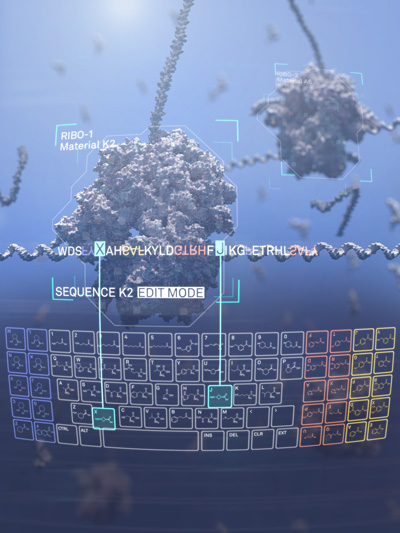Expanding the Palette of Monomers for Ribosome-mediated Polymerization
Increasing the chemical substrate palette used by engineered ribosomes to synthesize biopolymers could lead to new medicines and materials
Northwestern Engineering synthetic biologists have expanded the capabilities of engineered ribosomes as a vehicle to synthesize novel biopolymers, setting the stage for developing new medications and materials.
From therapeutics like insulin to industrial enzymes found in cleaning products to more durable, stronger materials like spider silk — scientists have transformed society by genetically reprogramming ribosomes to produce numerous bio-based products. In nature, however, the products of the ribosome are made up of almost exclusively alpha-amino acids, which are linked together in a specified order to form long chains called proteins. Just as if an artist is limited to only a few colors to paint with, this limited palette constrains the kinds of products that can be made.
In recent years, scientists have begun to expand that palette, leading to a new wave of applications, like drugs that combat rising antibiotic resistance. Despite this success, getting the ribosome to polymerize non-alpha amino acids has been a particularly difficult because the biological machinery involved in the process has poor compatibility with substrates not from nature.
 “While a diverse set of non-natural alpha-amino acids have been used by the ribosome before, our work shows that the ribosome is capable of polymerizing so much more. We demonstrate polymerization of a wide-range of backbone-extended and cyclic amino acid structures,” said Michael Jewett, Walter P. Murphy Professor of Chemical and Biological Engineering at the McCormick School of Engineering, who led the study. “We’ve provided a new rainbow of colors to the ribosome, and this will open the door to novel medicines and materials created using engineered ribosomes.”
“While a diverse set of non-natural alpha-amino acids have been used by the ribosome before, our work shows that the ribosome is capable of polymerizing so much more. We demonstrate polymerization of a wide-range of backbone-extended and cyclic amino acid structures,” said Michael Jewett, Walter P. Murphy Professor of Chemical and Biological Engineering at the McCormick School of Engineering, who led the study. “We’ve provided a new rainbow of colors to the ribosome, and this will open the door to novel medicines and materials created using engineered ribosomes.”
A paper about the work, “Ribosome-mediated polymerization of Long-carbon Chain and Cyclic Amino Acids into Peptides In Vitro” was published August 27 in the journal Nature Communications.
This research builds on past studies from Jewett’s team, which included identifying the design rules that govern how monomers attach to transfer RNA (tRNA), the molecules that bring the monomers to the ribosome for protein synthesis, as well a toolkit they had previously created called RISE (ribosome synthesis and evolution), which develops hundreds of mutant ribosomes in vitro without traditional cell viability constraints.
Guided by their earlier findings, the researchers designed a group of backbone-extended monomers — characterized by their long-chained carbon structures — and incorporated them into the ribosomes in vitro. This bypassed a traditional sticking point in the process, as current methods to charge monomers to tRNA are difficult and time-consuming. The team designed the monomers’ lengthened carbon chain to control the intramolecular reaction charge of tRNA, making it easier to carry the monomers to the ribosome for protein synthesis.
 Because the ribosome has evolved over billions of years to use alpha-amino acids, the team also used engineered ribosomes, capable of incorporating their designed amino acids into peptides more efficiently.
Because the ribosome has evolved over billions of years to use alpha-amino acids, the team also used engineered ribosomes, capable of incorporating their designed amino acids into peptides more efficiently.
“The ribosome can be considered the chef of translation,” said Jewett, who directs Northwestern’s Center for Synthetic Biology. “It’s like we trained different chefs to cook specialized cuisines.”
Access to a broader group of monomers for ribosome-mediated polymerization could expand the number of polymers that could be synthesized in a sequence-defined manner. That in turn could lead to the design and development of more precise and impactful medicines and materials, like next generation Kevlar and nylon. The monomers used in this study could, for example, also be used with in vitro screening and selection methods to discover new peptide drugs to treat diseases like diabetes.
“I am continuously humbled by how amazing the ribosome is,” Jewett said. “By using the ribosome to incorporate these amino acids into new classes of polymers, we set the stage to tackle the ‘holy grail’ of polymer science — to synthesize sequence-defined polymers made of chemical substrates.”